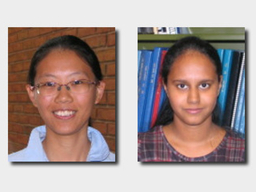Location
Online
Date & Time
November 11, 2020, 11:00 am – 12:00 pm
Description
| Session Chair: | Abhishek Balakrishna |
| Discussant: | Dr. Justin Webster |
Speaker 1: Mingkai Yu
- Title
- State and parameter estimation from exact partial state observation in stochastic reaction networks
- Abstract
- Fluorescent technologies make it possible to measure the dynamics of a small number of key molecular species within a single living cell. This gives rise to the problem of estimating the unobserved molecule counts of the species in the chemical reaction system given the measured data of few observed species. Estimating reaction rates in the system is also of interest. As reaction networks can be modeled by discrete state, continuous-time Markov process, a state vector represents the molecule counts of the species. We assume that some of the states are observed noiselessly in continuous time, while the rest are latent. In this talk, we provide a novel particle filter method for estimating unobserved states and parameters based on the temporal observation of some of the species. We first present the filtering equations which describe the time evolution of the conditional probability distribution of the unobserved state. We then provide a weighted Monte Carlo simulation algorithm to approximate the corresponding solution. We also show how our algorithm can be adapted for a Bayesian estimation of parameters.
Speaker 2: Nadeesri Wijekoon
- Title
- Composite likelihood estimation for conditionally specified models
- Abstract
- In practice, Maximum Likelihood is the preferred estimation method of parametric models. However, if the likelihood function is complicated or contains an awkward normalizing constant, estimation using Maximum likelihood becomes difficult. It is especially difficult to use ML in conditionally specified distributions estimating, as well as computationally costly. Composite Likelihood is one of the approaches available to tackle this issue. In this presentation, we present some important results of composite likelihood with some motivating examples. Further, we briefly discuss how this method can be applied to conditionally specified models. Numerical comparisons of maximum likelihood vs. composite likelihood will also be presented.
Tags:
